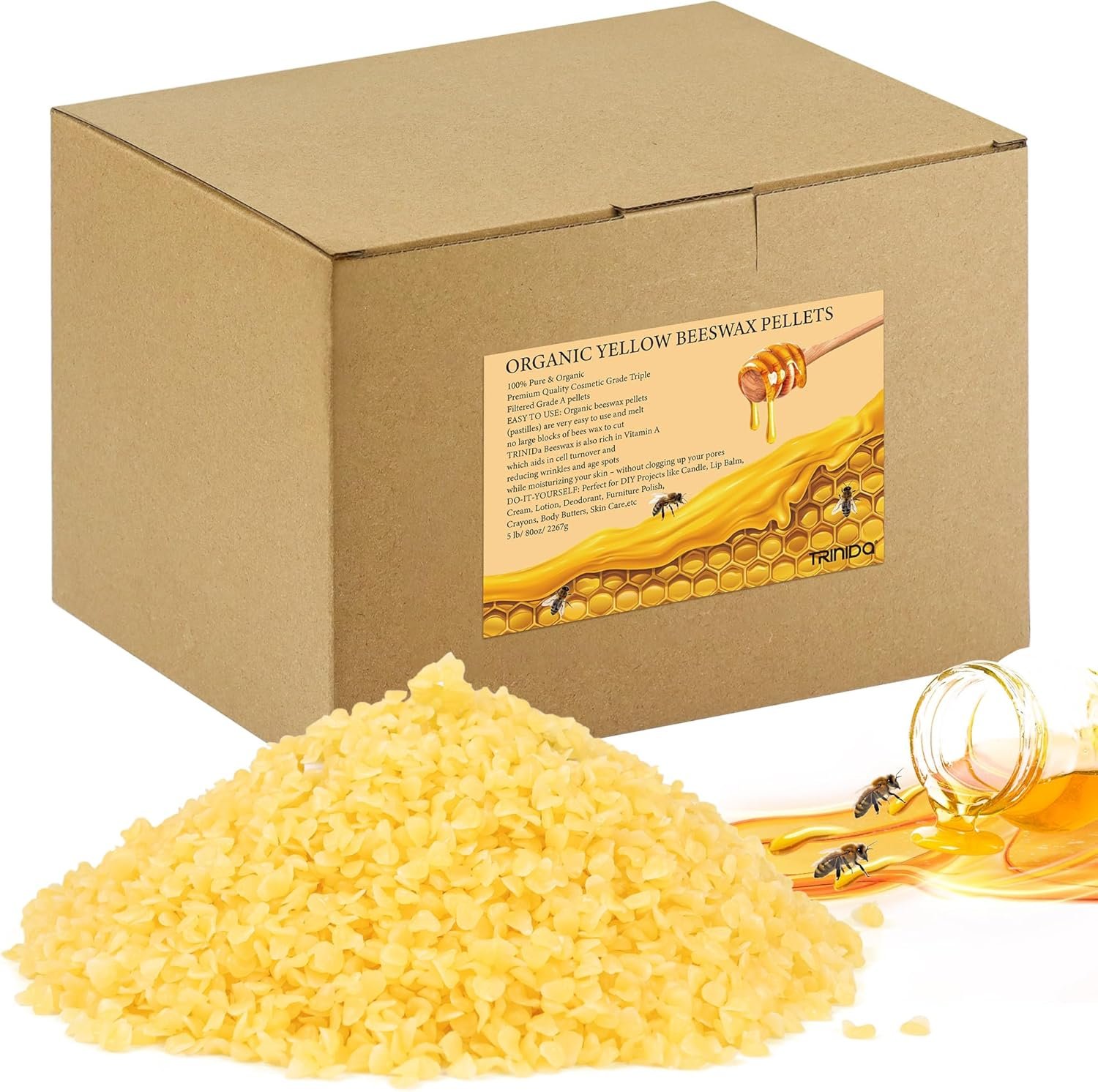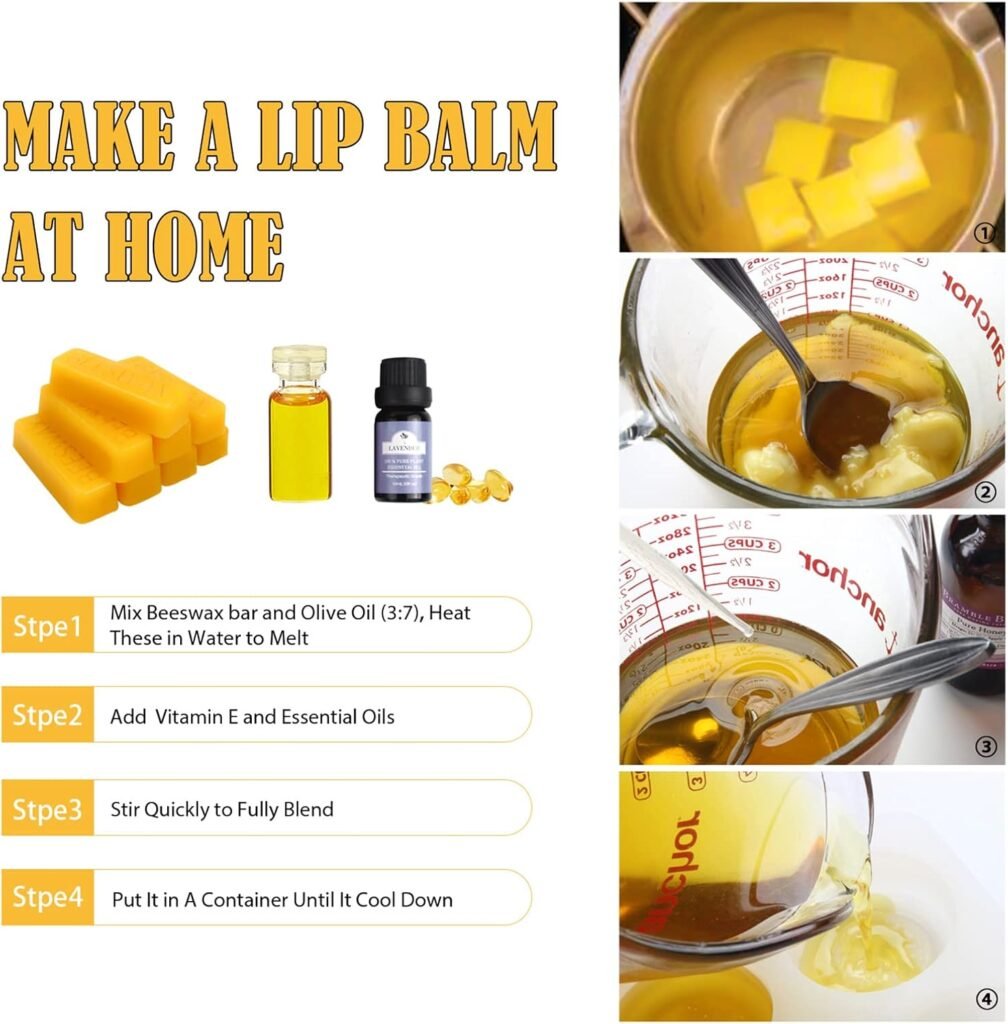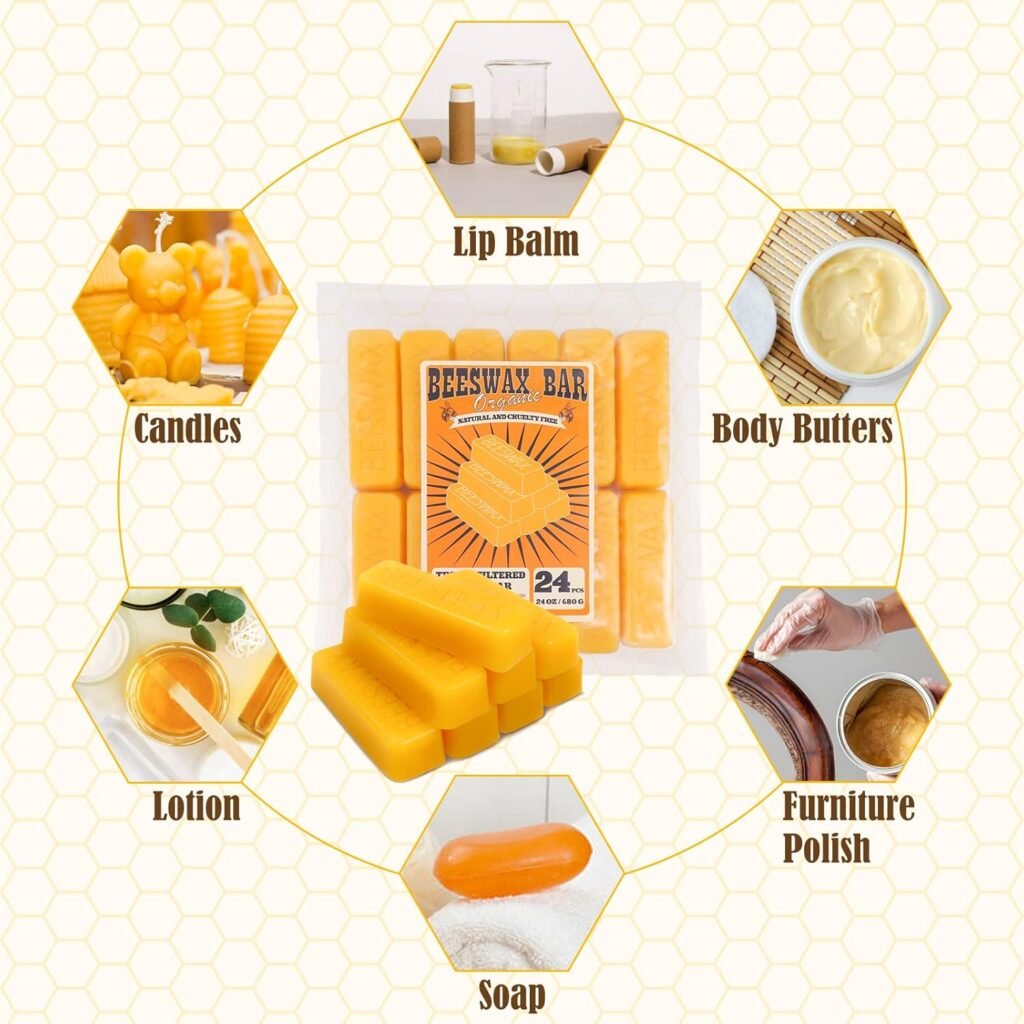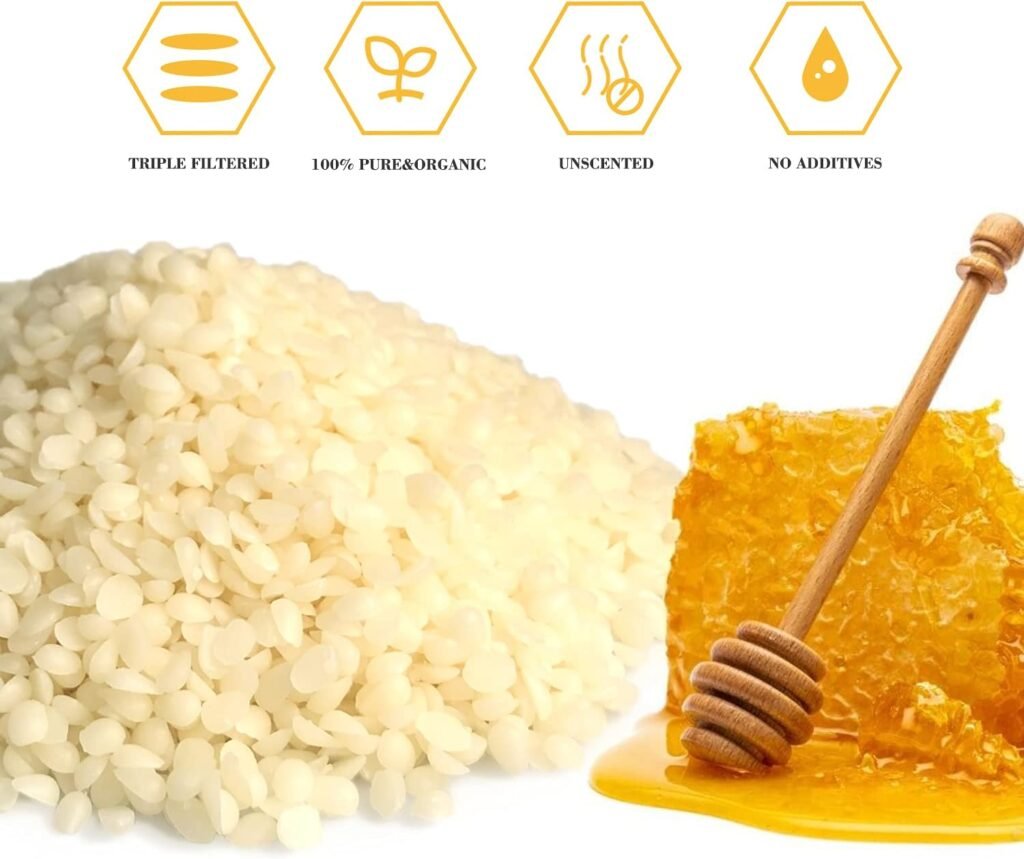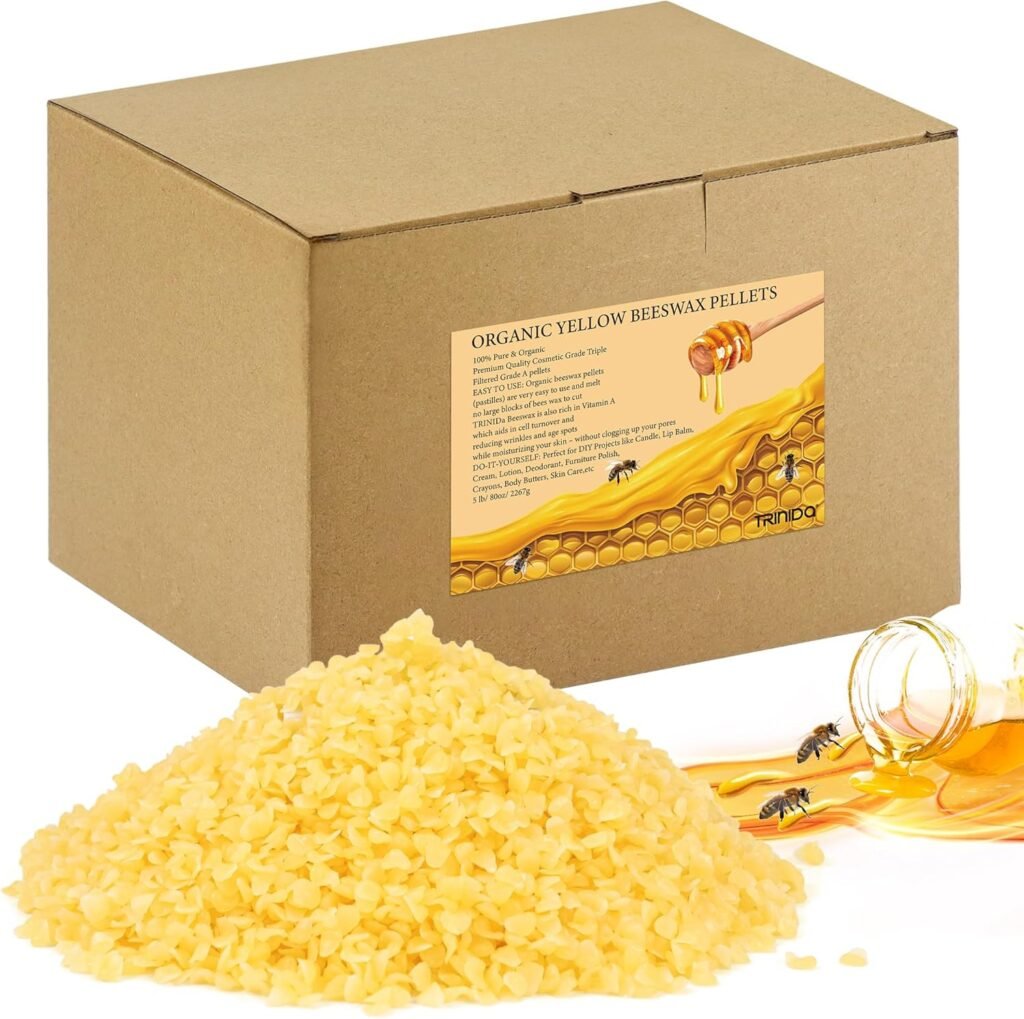Looking for a reliable, versatile beeswax to use in candles, skincare, and DIY projects around your home?
Product Overview
You’ll find that TRINIDa Beeswax Pellets 2LB(32 oz), Organic White Bees Wax for DIY Candles, Beeswax for Candle Making, Skin, Body, Face, and Hair Care, Lotions, DIY Creams, Lip Balm and Soap Making Supplies is marketed as a multi-purpose, cosmetic-grade beeswax designed for hobbyists and small-scale makers. This review walks through the product’s strengths, weaknesses, practical uses, and tips so you can decide whether it fits your needs.
What this product is
This is a two-pound (32-ounce) bag of white beeswax pellets intended for a wide variety of DIY uses including candles, cosmetics, and soaps. The pellets are promoted as triple-filtered and 100% organic with no additives.
Key features
The main selling points are its pellet form for easy measuring and melting, cosmetic-grade purity for use on skin, and organic filtration process intended to remove impurities. The manufacturer also highlights multiple DIY uses and gift-making potential for holidays and family activities.
Quick Specifications Table
Below is a concise breakdown to help you assess the main specs at a glance. This should make it easier for you to compare to other supplies in your toolkit.
| Feature | Details |
|---|---|
| Product name | TRINIDa Beeswax Pellets 2LB (32 oz), Organic White Bees Wax |
| Form | Pellets |
| Weight | 2 LB (32 oz) |
| Purity | Claimed 100% organic, triple-filtered |
| Grade | Cosmetic grade (as stated) |
| Common uses | Candles, lip balm, lotions, creams, soap, crayons, furniture care |
| Scent | Mild, natural beeswax aroma |
| Packaging | Resealable bag (varies by seller) |
You can use this table to quickly compare the product specs against other beeswax options you might be considering. Remember that exact packaging or slight variations could occur depending on the seller and batch.
Packaging and Presentation
When you open the bag, you’ll typically find small uniform pellets that are easy to scoop and measure, which helps speed up recipe prep. The packaging tends to be a basic resealable pouch or bag, which keeps pellets contained and reduces spills.
Bag integrity and freshness
You’ll want to check the bag for a secure seal when you receive it; a resealable bag helps keep moisture and contaminants out, which is important for cosmetic uses. If you plan to store the beeswax long-term, transfer it to an airtight container to maximize shelf life and prevent the wax from absorbing odors.
Pellet consistency and convenience
Pellets save you the time of chopping or grating blocks of wax, and they melt evenly in a double boiler or melting pot. The uniform size also makes it easier to calculate ingredient ratios for recipes like balms or small-batch candles.
Performance and Use Cases
This beeswax performs well across many DIY applications, and you’ll appreciate its versatility if you make both crafts and personal care items. The solid, white pellets hold scent and oils well and blend smoothly when heated with carrier oils or other waxes.
Candle making
For candles, the pellets melt easily and blend well with fragrance oils and dyes, offering predictable burn behavior when paired with the right wick and container. You’ll need to test wick types and scent load to dial in proper burn time and melt pool behavior for your specific candle sizes.
Skin, body, face, and hair care
Because the product is marketed as cosmetic-grade, you can use it in balms, emollient bars, and salves where beeswax provides structure and skin-protecting properties. Always patch-test on your skin, especially if you have sensitivities, and follow sanitization best practices when making products for the face.
Lip balm, lotions, and creams
Pellets make it easier to measure small quantities, which is handy for lip balm tins and travel-size creams. Beeswax adds a protective barrier and a smooth texture to balms, but you’ll want to balance it with soft oils and butters to avoid overly firm formulas.
Soap making and other crafts
You can incorporate beeswax into melt-and-pour soap bases or cold-process soaps to increase hardness and add a stable, natural barrier. It’s also useful for making crayons, wax seals, and furniture polish. Expect subtle differences in soap curing and feel depending on percentage used.
Quality and Ingredients
The manufacturer claims the beeswax is 100% organic and triple-filtered, suggesting attention to removing impurities and contaminants. While you can’t always verify organic certifications from the packaging alone, the filtration and cosmetic-grade labeling are useful indicators for crafting purposes.
Purity and filtration
Triple filtration implies that the wax has undergone multiple passes to remove particulates, which should yield a cleaner melt and lighter color compared to raw, unfiltered yellow wax. If you need certified organic documentation, request details from the seller or brand.
Cosmetic grade claims
Cosmetic grade typically means the wax has been processed and tested for safe topical use in personal care products. That said, “cosmetic grade” is a label rather than a formal regulatory guarantee, so you should still follow good manufacturing practices and test your finished products.
Organic certification and sourcing
The product description uses the term “organic,” but it doesn’t provide explicit certification details on the package. If certified organic status is critical for your brand or intended market, ask the seller for documentation or look for third-party certification labels.
Texture, Scent, and Color
You’ll notice that white beeswax has a milder scent and lighter color compared to raw yellow beeswax. The pellet form keeps texture consistent so it blends reliably with oils and butters in your formulas.
Pellets form advantage
Small pellets are user-friendly and reduce prep time, which you’ll appreciate during repetitive production runs or when making several formulations at once. They also weigh and melt more uniformly, minimizing hot spots when heating.
White beeswax specifics
White beeswax is typically bleached or filtered to remove the pollen and pigments found in raw wax, resulting in a more neutral appearance. The scent is subtle and natural, which means it won’t strongly interfere with fragrance oils or essential oils you add.
Melting point and handling
Beeswax has a relatively high melting point (around 62–65°C / 144–149°F for pure beeswax), so you’ll need a gentle heat source or double boiler to prevent scorching. Work slowly and avoid direct flames; beeswax can catch fire if overheated.
Pros and Cons
You’ll find several strengths with this product, but there are also a few limitations you should consider. Weigh these pros and cons against your intended uses to determine if this 2LB bag is the right fit.
Advantages
The pellet format simplifies measuring and melting, the claimed triple filtration yields a cleaner product, and the 2-pound size gives you a solid stock for multiple projects. It’s a great all-around choice if you make candles, cosmetics, and small home-care items.
Potential drawbacks
If you need certified organic documentation, the product description alone may not be sufficient, so you may need to verify certifications. Also, white beeswax can be more processed than raw yellow beeswax, which might matter if you prefer minimally processed, full-spectrum wax.
How to Use (Step-by-step)
Below are practical, step-by-step methods for several common applications so you can get started quickly and safely. Each method includes temperature and ratio guidance, but remember to test and adapt for your specific recipes and environment.
General melting method
Use a double boiler or a dedicated wax melter to melt beeswax pellets slowly over medium-low heat until fully liquefied. Stir occasionally with a clean, heat-resistant utensil to ensure even melting and prevent hot spots.
Measuring and safety
Always measure ingredients by weight for repeatable results, and use a kitchen or lab scale for accuracy. Wear heat-resistant gloves when handling hot containers, and keep a thermometer nearby to monitor temperatures.
Making container candles
A simple container candle recipe: 1 part beeswax to 1 part soy wax or up to 30% fragrance load depending on your wax blend and fragrance oil compatibility. Preheat containers slightly, secure the wick centered, pour at recommended pour temperatures (usually 130–160°F depending on blend), and cure for 24–48 hours before burning.
Making lip balm
A basic lip balm formula: 1 part beeswax pellets, 2 parts carrier oil (like sweet almond or jojoba), and 1 part butter (like shea or cocoa). Melt together, remove from heat, add flavor or essential oils at safe usage rates, pour into tins, and allow to set.
Making lotion bars
Lotion bar base: 1 part beeswax, 2 parts butter (shea or cocoa), 3 parts liquid oil. Melt, pour into molds, and cool. These bars are solid at room temperature and melt with body heat to moisturize.
Using beeswax in soap
Add beeswax at 1–10% of soap formula by weight depending on desired hardness and scent retention. In cold process soap, incorporate melted beeswax into the oils before lye addition to ensure proper emulsification.
Recipes and Formulations
The following starter recipes give you a practical foundation you can modify to suit your fragrance, texture, and aesthetic preferences. Use precise weights and test small batches before scaling up.
Basic beeswax candle (small jar)
- 8 oz beeswax pellets
- 2 oz soy wax (optional — helps lower melt point)
- 1 oz fragrance oil (adjust based on manufacturer’s hot throw recommendations) Melt wax, stir in fragrance off heat, secure wick in jar, pour at ~140°F, cool for 24 hours.
Simple lip balm (10 ml tin)
- 4 g beeswax pellets
- 8 g carrier oil (castor, jojoba, or sweet almond)
- 8 g butter (shea or cocoa) Melt, add 1% flavor oil or essential oil safely, pour into tins, cool.
Lotion bar (molded bar)
- 1 part beeswax
- 2 parts shea butter
- 3 parts sweet almond oil Melt wax and butter, stir in oil, pour into molds, cool and demold.
Furniture wax polish
- 1 part beeswax
- 4 parts mineral oil or walnut oil Melt together, apply thinly to wood with a soft cloth, buff to shine.
Crayon recipe for kids
- 1 part beeswax pellets
- 1 part paraffin or wax flake (optional)
- Crayon pigment or melted candle wax dye Melt, stir pigment in, pour into silicone molds. Cool before giving to children.
Each of these recipes can be scaled by weight. Keep notes on the exact measurements and processing temperatures so you can replicate or refine your formulas.
Safety and Allergies
You should always treat beeswax as a natural ingredient that can still cause sensitivities in some people and requires careful handling when heated. Follow common-sense precautions to protect yourself and others.
Patch testing and skin sensitivity
Before using new formulations on sensitive skin or the face, perform a small patch test on the inner forearm and wait 24–48 hours to monitor for irritation. If you experience any redness, itching, or swelling, discontinue use and consider seeking medical advice.
Handling hot wax and flammability
Heat beeswax gently and monitor temperatures; never leave a melting pot unattended. Keep a fire extinguisher rated for grease or wax fires in the work area—do not use water on wax fires.
Storage and shelf life
Store pellets in a cool, dry place away from direct sunlight and strong odors; an airtight container will prolong freshness. Beeswax is relatively stable but can soften or absorb odors if exposed to heat or contaminants.
Comparisons with Other Waxes
If you’re deciding between waxes, here are practical comparisons to help you choose based on your priorities—hardness, scent, vegan status, and cost.
White beeswax vs. yellow beeswax
White beeswax is filtered and lighter in color, making it more neutral for cosmetics and pale candles, while yellow beeswax retains more natural pigments and a stronger honey scent. If you want minimal color or scent interference in your product, white beeswax is a good choice.
Beeswax vs. soy wax for candles
Beeswax burns cleanly and has a natural glow, but it’s more expensive than soy and has a higher melting point. Soy wax is vegan and often holds fragrance well, but it can feel softer and may require additives for structure.
Beeswax vs. paraffin
Paraffin is a petroleum-derived wax that’s inexpensive and has strong fragrance throw, but it’s not natural and can produce soot. Beeswax is natural, renewable, and produces minimal soot, making it preferable for eco-conscious makers and indoor use.
Beeswax vs. plant-based waxes (candelilla, carnauba)
Plant-based waxes are vegan alternatives; they often burn differently and have different melting points. Candelilla and carnauba are much harder and useful as binders or to raise melt points in specific formulations, but they won’t provide the natural honey-like properties of beeswax.
Packaging Sizes and Value
A 2LB (32 oz) bag is a practical size for hobbyists and small-batch producers—you’ll have enough material for multiple projects without needing massive storage. For frequent makers or small businesses, look into bulk sizes to reduce cost per ounce.
Cost-effectiveness for small-batch makers
If you make gifts, small candle series, or cosmetic samples, the 2LB size hits a sweet spot between convenience and value. Buying larger quantities can lower your per-unit cost, but also requires more storage space and turnover.
When to consider larger quantities
If you consistently produce dozens of units per month, larger packaging (5 lb, 10 lb, or bulk drums) can be more economical. Ensure you have appropriate storage to maintain quality when buying in larger quantities.
Environmental and Ethical Considerations
As a natural product, beeswax has favorable environmental credentials when sourced responsibly, but the sustainability picture depends on beekeeping practices and supply chain transparency. You’ll want to consider how and where the beeswax is sourced if ethical sourcing is a priority.
Sustainability of beeswax
Proper beekeeping that supports colony health and biodiversity can make beeswax a responsible choice, but intensive industrial practices can harm bees and reduce local ecological benefits. Ask sellers about sourcing practices, regional origin, and beekeeper relationships when possible.
Bee welfare and supply chain transparency
Some suppliers partner directly with small-scale beekeepers or cooperatives, which improves transparency and traceability. If you’re building a brand that markets sustainability, request supplier information or certifications to accurately represent your sourcing.
Maintenance and Storage Tips
Storing and handling beeswax correctly will keep your supplies ready for use and maintain product performance over time. Small steps in storage and handling can prevent contamination and extend shelf life.
Store in a cool, dry place
Avoid storing the wax where temperature fluctuates or where it could absorb odors—an airtight plastic or glass container in a cool cupboard is ideal. Keep it away from solvents and strong-smelling substances.
Avoid moisture and contamination
Beeswax does not dissolve in water, but moisture and particulates can negatively affect the wax; always use clean spoons, containers, and utensils to scoop pellets. For cosmetic-grade production, maintain a clean workspace and sanitize containers to reduce contamination risks.
Troubleshooting Common Issues
When working with beeswax, you may encounter common problems like grainy texture, poor adhesion, or uneven burning; most issues have straightforward fixes. Here’s how to approach those challenges so your projects turn out better.
Grainy texture in creams or balms
Graininess happens when the wax crystallizes improperly or the mixture cools too quickly. Fix this by heating gently and stirring thoroughly while cooling more slowly, or increase the ratio of carrier oils to wax to reduce stiffness.
Scent masking or poor fragrance throw in candles
Beeswax’s natural scent can slightly mute added fragrance oils—use fragrance oils specifically rated for beeswax and test higher usage rates within safe limits. Also ensure proper pour temperature: too hot or too cold can trap scent and reduce throw.
Cracks or shrinkage in molded products
Rapid cooling or overly high wax ratios can cause shrinkage and cracks in molded items like lotion bars. Pour at recommended temperatures and allow a gradual cooling period at room temperature to minimize these effects.
Wax separation in emulsions
If lotions or creams separate, the emulsion wasn’t stable. Use an emulsifier (like emulsifying wax or a stable natural emulsifier) and maintain proper temperatures during emulsification for a stable final product.
Who Should Buy This
This product suits hobbyists, crafters, and small-batch cosmetic makers who want convenience and a cleaner-looking wax for their projects. If you value pellet convenience and are making candles, balms, or household polishes, this beeswax is well-suited for your needs.
Not ideal for
If you require certified organic documentation or single-origin, traceable supply chains for a branded product, you might need to verify details with the seller or consider suppliers with explicit certification. Also, if you prefer minimal processing, raw yellow beeswax might better match your preferences.
Final Verdict
TRINIDa Beeswax Pellets 2LB (32 oz) is a versatile, easy-to-use product for DIYers and small-scale formulators seeking a clean, cosmetic-grade beeswax in pellet form. You’ll likely appreciate the convenience, predictable performance, and wide range of uses, but confirm sourcing or certifications if those are important to your brand or personal values.
Frequently Asked Questions (FAQ)
Below are common questions you might have when deciding to purchase and use this beeswax.
Is this beeswax safe for skin?
The manufacturer states it’s cosmetic grade, making it suitable for topical products, but you should always patch-test new products before full use. If you have allergies to bee products, consult with a healthcare professional before using.
Can you use this beeswax for candle making with fragrance oils?
Yes, you can. Test fragrance compatibility and pour temperatures to achieve the best scent throw; some fragrance oils are better suited for beeswax than others.
How long will this beeswax last in storage?
Stored properly in a cool, dry place, beeswax can last several years without significant degradation. Keep it away from heat and odors to preserve quality.
How should you melt the pellets?
Use a double boiler, dedicated wax melter, or a slow cooker on low; avoid direct heat and open flames to reduce fire risk. Stir occasionally and monitor temperature with a thermometer.
Are these pellets bleached or chemically treated?
They are described as white and triple-filtered, which typically involves processing to remove color and impurities. If you need to confirm absence of chemical bleaching agents, request details from the seller.
Can you use this product for food-contact items like wraps or coatings?
While beeswax is traditionally used for food wraps, packaging materials and safety depend on processing and any added ingredients. Verify the product’s food-grade suitability with the seller before using it in direct food-contact applications.
Disclosure: As an Amazon Associate, I earn from qualifying purchases.
